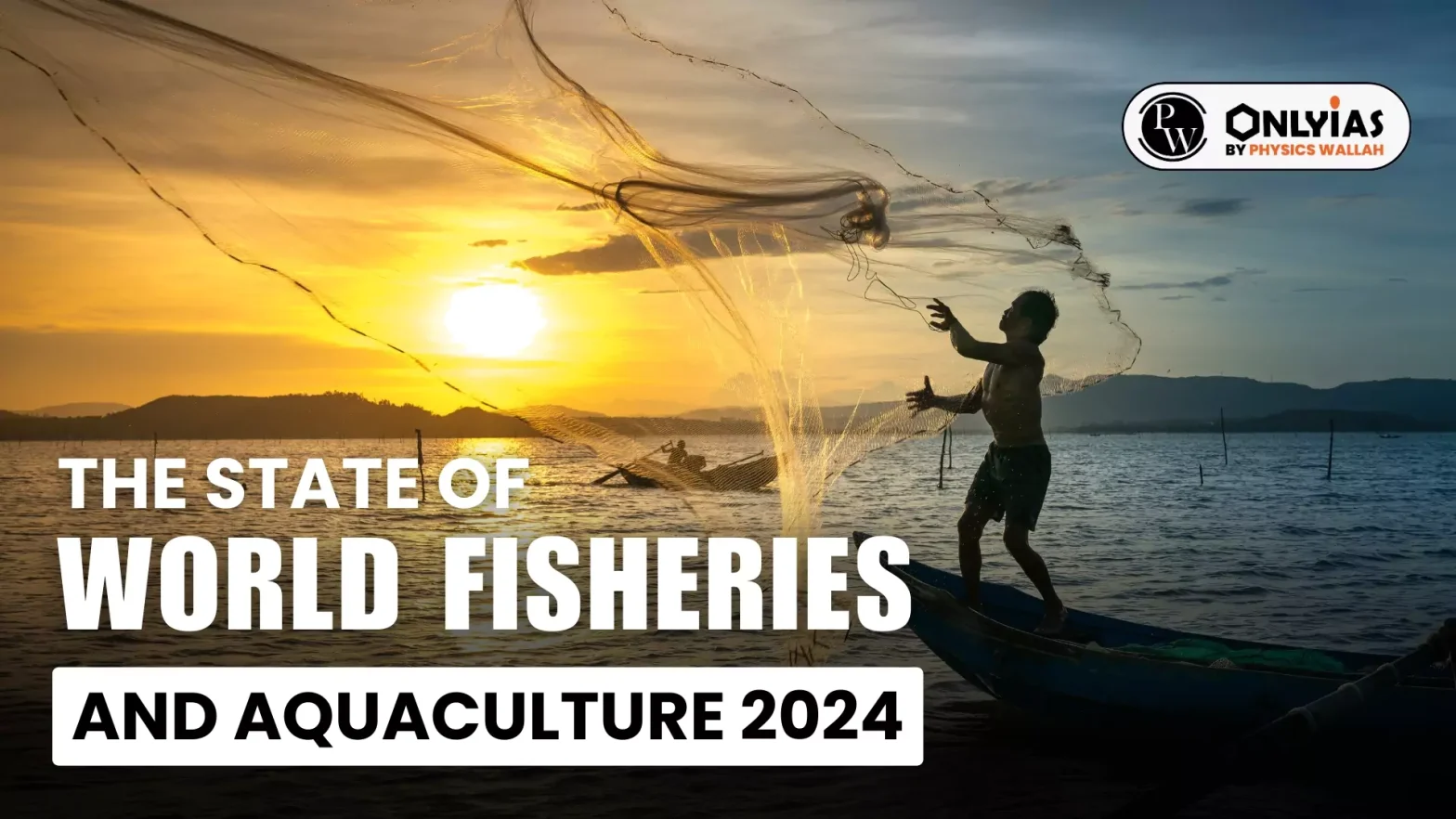The Food and Agriculture Organization of the United Nations (FAO) has recently released “the State of World Fisheries and Aquaculture (SOFIA) 2024”.
- The 2024 edition spotlights the concrete advances of Blue Transformation in action, showcasing the role of FAO, in driving change towards sustainable aquaculture expansion and intensification.
About State of World Fisheries and Aquaculture (SOFIA)
SOFIA is an FAO flagship report that analyzes the status and health of global fishery stocks as well as trends in fisheries and aquaculture at a global and regional level.
Blue Transformation in Action:
- Introduction: By FAO in “Blue Transformation” vision in 2021.
- Aim: To leverage aquatic food systems, to enhance food security, improve nutrition, etc
- Objectives:
- Sustainable aquaculture expansion to meet global demand, with equitable benefit distribution.
- Effective fisheries management for healthy stocks and fair livelihoods.
- Upgraded aquatic value chains, ensuring social, economic, and environmental sustainability.
|
Crucial Insights on the State of World Fisheries and Aquaculture 2024
- The Statistics:
- On Production:
- Global fisheries and Aquaculture: 223.2 million tonnes
- Global Aquaculture: 130.9 million tonnes
- Aquatic Animals: 185.4 million tonnes
- Region Wise: Asia (70%), Europe (9%), Latin America and the Caribbean (9%), Africa (7%), Northern America (3%) and Oceania (1%).
- Country Wise: China (36%), India (8%), Indonesia (7%), Viet Nam (5%) and Peru (3%)
- Algae: 37.8 million tonnes
- Global Capture Fisheries: 92.3 million tonnes
- On Sustainability:
- Proportion of sustainably fished marine stocks monitored by FAO (2021): 62.3%
- Proportion of sustainably fished marine stocks level monitored by FAO weighted by production (2021): 78.9%
Enroll now for UPSC Online Course
-
- On Consumption:
- Global apparent consumption of aquatic animal foods (2021): 162.5 million tonnes
- Global apparent consumption of aquatic foods per capita (2021): 20.6 kg
- Increase in global apparent consumption of aquatic foods per capita: from 9.1 kg in 1961 to 20.6 in 2021
- On Employment:
- People employed in primary production: 61.8 million
- Workers by Sector: Fisheries (54%), Aquaculture (36%), Sector not specified (10%)
- Percentage of jobs by region: Asia (85%), Africa (10%), Latin America and the Caribbean (4%), Europe, Oceania and Northern America combined (1%).
- On Trade:
- Top exporters of aquatic animal products: China, Norway, Viet Nam, Ecuador, Chile
- Top importers of aquatic animal products: The United States of America, China, Japan, Spain, France
- Value of international trade of aquatic products: USD 195 billion
- Rise in Production: World fisheries and aquaculture production has hit a new high in 2022 with a surge of 223.2 million tonnes, a 4.4% increase from the year 2020.
- For the first time in history, in 2022, aquaculture surpassed capture fisheries as the main producer of aquatic animals.
- Despite the growth in aquaculture, capture fisheries remain an essential source of aquatic animal production.
- With 1.9 million tonnes, India ranked first in inland fisheries production.
- Inland Resources: These include rivers and canals, floodplain lakes, ponds and tanks, reservoirs, brackish water, saline/alkaline-affected areas, etc.
- Countries Dominating Aquaculture: China, Indonesia, India, Vietnam, Bangladesh, the Philippines, the Republic of Korea, Norway, Egypt, and Chile – produced over 89.8% of the total.
- But many low-income countries in Africa and Asia are not using their full potential.
- Rise in Global Consumption of Aquatic Foods: Global consumption of aquatic animal foods reached 162.5 million tonnes in 2021 due to its potential in tackling food insecurity and malnutrition.
- Impact of Population Rise: Due to the rising global population, to maintain through to 2050 apparent consumption of aquatic animal foods at the 2022 estimated level of 20.7 kg per capita would require an increase in the total aquatic animal food supply of 36 million tonnes, a rise of 22%.
- This highlights the need to accelerate Blue Transformation priority actions in a world where aquatic foods play a more significant role in ending hunger, malnutrition and poverty.
- Actions Required:
- Further Transformative and Adaptive Actions: These are needed to strengthen the efficiency, inclusiveness, resilience and sustainability of aquatic food systems.
- These are also needed to consolidate their role in addressing food insecurity, poverty alleviation and sustainable governance.
- Boost Sustainable Aquaculture: Targeted policies, technology transfer, capacity building and responsible investment are crucial to boost sustainable aquaculture, especially in Africa.
- Supporting further Consumption: Consumption from sustainable sources is crucial to foster healthy diets and improve nutrition worldwide.
- Aquatic foods provide high-quality proteins and key nutrients including omega-3 fatty acids, minerals, and vitamins.
Check Out UPSC NCERT Textbooks From PW Store
Government Initiatives For India’s Fisheries Sector
- Marine Fisheries Management: Fisheries are state subjects under the Seventh Schedule of the Constitution of India. Fishing and fisheries beyond territorial waters are on the Union list.
- Pradhan Mantri Matsya Sampada Scheme (PMMSY): To address significant productivity and production gaps in the fisheries sector, infuse innovation and cutting-edge technology, etc.
Associated International Initiatives
- The 2023 United Nations Framework Convention on Climate Change (UNFCCC) Ocean Dialogue recognized the potential of aquatic foods for providing critical climate solutions.
- In 2023, UN members agreed to a legally binding treaty for conserving and sustainably using marine biological diversity of areas beyond national jurisdiction.
- FAO integrates traditional knowledge for adapting to climate change in specific areas, like local species suited for evolving conditions.
|
![]() 12 Jun 2024
12 Jun 2024

